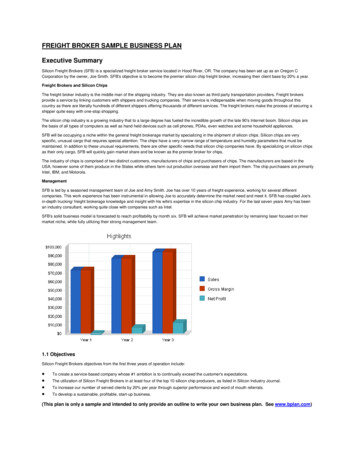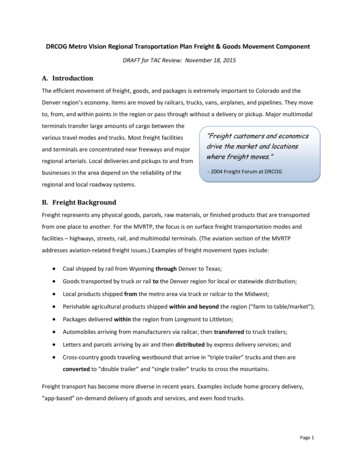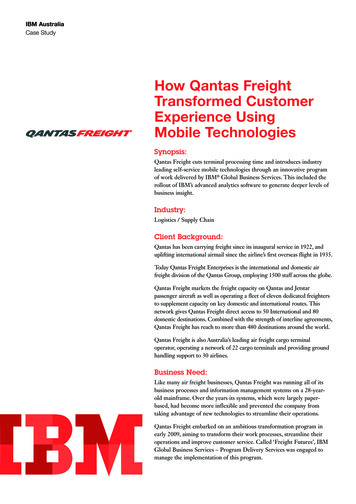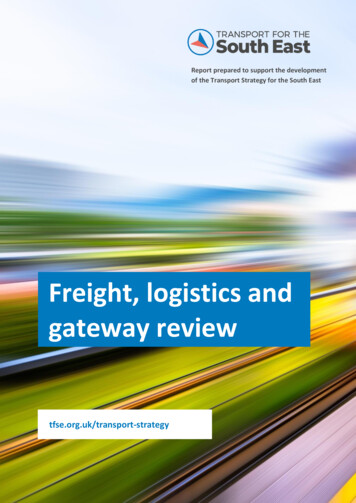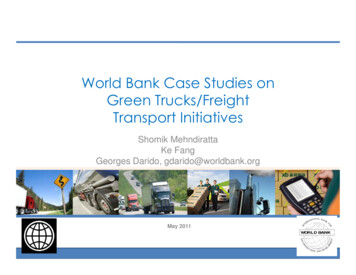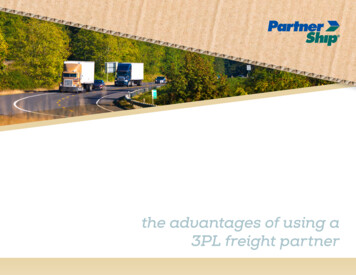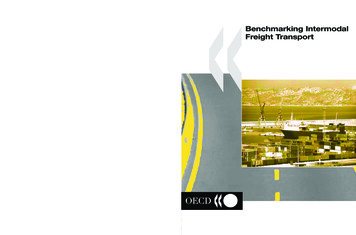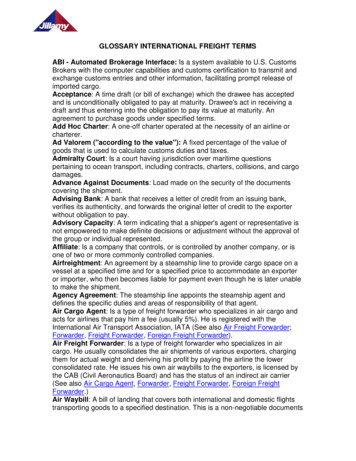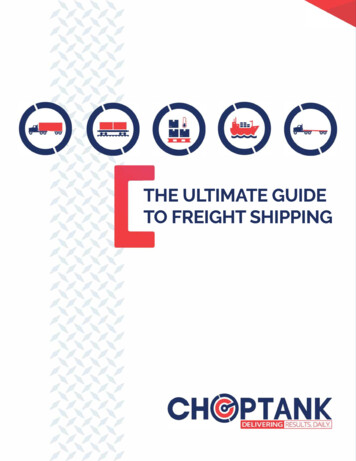
Transcription
THE ULTIMATE GUIDETO FREIGHT SHIPPING
ABLE OF CONTENTSPG TOPIC 1What is Freight?2Types of Freight and Freight Modes4Common Truck Freight & Trailer Types5Freight Class & Density8Freight Pricing10 Accessorial Guidelines11Freight Claims12 How to Ship Freight15 Packaging19 How to Choose a Provider
Freight transport is the physical process of transporting commodities andmerchandise goods and cargo. The term shipping originally referred to trans port by sea but in American English, it has been extended to refer to transportby land or air (International English: "carriage") as well. "Logistics", a term bor rowed from the military environment, is also used in the same sense.In current times freight refers to B2B/commercial shipments that are larger inquantity or larger than your typical parcel size, or weight, handled by standardcarriers. Goods are put into cardboard boxes, loaded on pallets, and movedusing many different modes of transportation.Freight vs. ParcelParcels are smaller, lighter, individual shipments handled by carriers such asthe US Postal Service, UPS, and FedEx. Consumers can drop off these ship ments at various locations at their convenience and pricing is determined bydimensional weight or the actual weight. Commercial shippers, or business'swill typically have a daily pickup arranged with carriers such as UPS or FedEx.FedEx and UPS specific size and weight limits on the parcels. Anything larger isconsidered a freight shipment.Freight pricing has a multitude of factors including distance, size, class, fueland many others that are constantly changing due to the marketplace. Ship ments are managed by a third-party logistics (3PL) company or directly withthe carrier. The third party manages everything including how the freight is tobe loaded, scheduling delivering and transport time, any special equipmentneeded, and other necessary pieces of information to facilitate the delivery.Click here to get freight quotes.NOTE: If viewing this digitally, there are links throughout the document which providefurther information on the topic at hand. If printed, see the resource page for correspondingweb sites.125
EvPES OF FREIGHT AND FREIGHT MODESLTL (Less Than Truckload)LTL freight includes freight shipments that do not completely occupy an entire truck trail er. Mos freight trailers on the road today are 8' - 8.5' wide, 12.5' - 13.5' high, and 40' - 53'long. This allows carriers to load several LTL shipments into a single truck and servicemultiple customers and destinations. LTL freight shipments typically weigh between 200and 10,000 lbs. Common LTL carriers include Con-way, Old Dominion Freight Lines, YRCFreight, FedEx Freight, and many more. Click here to get quotes on LTL shipments.Partial TruckloadPartial truckload shipments are shipments that don't completely fill the truck, but tend toremain on a single truck similar to full truckload shipments. As a result, they are subjectedto less handling than LTL shipments. Average partial truckload shipments fall between LTLand FTL sizes and weight. The core difference between LTL and Partial TL is the way it istransported rather than its size or weight.FTL (Full Truckload)Truckload freight includes all freight shipments that solely occupy a trailer. These are largevolume or weight shipments from point to point. Weight limits depend on the weight ofthe vehicle and local laws, but typically are around 34,000 - 45,000 lbs. in the US. The mostypical truckload shipments are transported via dry van, flatbed, and refrigerated trailers.Click here to get quotes on FTL shipments.t 6WNL.6AI N6W2 25
Air FreightAir freight is freight transported via cargo plane. Goods are transported first to the originairport then are flown to the destination airport where they are shipped via truck to a finaldestination. This is the fastest method of delivering goods between two destinations butalso one of the costliest. Air freight can transport items from one port to another in amatter of days rather than weeks for sea freight. There are some limitations to air freight,such as hazardous materials and other prohibited cargo. Click here to get quotes on airshipments.Ocean Freight / Sea FreightOcean freight is freight transported via ship from port to port. Shipments are organizedinto two primary categories; FCL (full container load) and LCL (less than container load).Containers are typically 20', 40', or 53' in length. Providers often offer expedited and econ omy options depending on your needs. An obvious limit to sea based freight is the prox imity to a serviceable port, but is overcome by using traditional land based transportationto get goods to, and from, ports. Click here to get quotes on port shipments.Rail FreightRail freight consists of goods carried via rail car over land. Shipments are arranged fromindividual rail cars to entire trains depending on the needs of the shipper. Individual railcar shipments can be carried by a wide array of specialty rail cars such as triple decker carcarriers, intermodal cars, and ore cars. Trains can only carry goods where there are tracks.However, trucks are used to transport freight to and from railways. Click here to getquotes on rail shipments.lntermodal Freightlntermodal freight is any combination of transportation modes; specifically truck, train,ship, and plane. lntermodal allows shipments to maximize the benefits of each mode toensure the most economical and timely outcome. lntermodal also can take a single originshipment and deliver it to multiple destinations. Limitations of intermodal include severalhandling events which can result in breakage along with specific organization require ments of each mode. Click here to get quotes on intermodal shipments.3 25
,, I.,' ' ,.,''' '' I ),1'-I. '-. EoMMON TRUCK FREIGHT & TRAILER TYPESDry Van Freight (see Trailer 101 Guide)Dry van trailers are covered trailers with a fat deck. Van trailers are the mos commontype of trailer utilized for freight transportation in the US. The box covers the load fromthe elements and helps to secure the load.Refrigerated (Reefer) Freight (see Trailer 101 Guide)Refrigerated freight includes shipments that require a temperature regulated trailer.Refrigerated trailers have a large capacity climate control unit mounted on the front ofthe trailer and run off of a secondary fuel supply. The trailers can be partitioned forzoned temperature control. Refrigerated shipments generally consist of perishable foodstuffs, medical supplies, or chemicals.Oversized Freight (see Heavy-Haul 101 Guide)Oversized freight is any load that exceeds the standard legal size and/or weight limits fora particular route. In mos US sates this includes loads that are wider than 8' 6" or tallerthan 13' 6". Loads that are excessively long (combination length) or heavy (total or peraxle) also fall into the oversized category. The regulations can vary sate by sate. Plus,bridges and roadways also have limitations that mus be addressed. As a result, carefulconsideration is given to planning specific routes. As an additional safety measure thetruck is accompanied by one or multiple pilot cars that act to warn motorists, control thetransportation, and ensure route safety.Flatbed Freight (see Trailer 101 Guide)Flatbed freight is any load that is put onto a flatbed trailer. Flatbed loads need to besecured by the driver and are open to the elements. Flatbeds, due to their open nature,allow certain loads, such as large generators, to be loaded with greater speed and safetysince a crane can be used rather than a forklift. They can also be loaded from both sidesand can accommodate full width loads.Flatbeds are very common in the US trucking industry and widely used for constructionand industrial loads.Lowboy Freight (see Trailer 101 Guide)Lowboy loads are very similar to flatbed loads. Lowboy trailers have a much lower deckheight which effectively lowers the total height of the load to avoid falling into oversizedload restrictions. This allows taller loads to be transported without the extra costs andsafety issues of an oversized load.4 25
REIGHT CLASSThe National Motor Freight Classification , or NMFC for short, is a system applied tocargo to allow the LTL industry to quickly organize, price, and understand shipments. Therating is known industry wide as freight class. There are 18 classes, ranging from Class 50to Class 500. These classes are determined by four yLiability/ ValueFreight DensityFreight density is the ratio of weight to volume expressed in per cubic foot (pcf) mea surements. Shipments that take up a lot of space for their weight will be in a higherfreight class and generally cost more to ship. Shipments that are heavy and compact willbe in a lower freight class and generally less expensive to ship. The Commodity Classifi cation Standards Board, or CCSB, samples numerous shipments for both the pcf densityand the frequency of that particular density being shipped. For example, night lightspackaged in boxes range in density between 2.17 to 22.50 pcf, with an average density of7.09 pcf according to CCSB research. As you can see from the graph below the vast ma jority of densities were between 4 and 10 pcf.50%FREQUENCY 3% 0.00%Density Intervals (pd)The classification example, night lights, and specific data in this section including density measurements, frequency distribution, and specificfindings are courtesy of the NMFTA Commodity Classification Standards Board and used with their permission. Source: NMFTA- CommodityClassification Standards Board- Docket 2015-2 Sbj. 10, AddendumS 25
HandlingCommodities that require special handling will typically have higher freight classes. Han dling takes into account how normal the typical handling requirements are for a particu lar good. Goods that are tendered into typical packages such as boxes or crates loadedonto pallet skids, aren't fragile or drop sensitive, will get lower freight class ratings com pared to more difficult shipments. For our example above, night lights are tendered intoboxes and placed onto pallets.Stow-abilityStow-ability is measured by how easily other freight can be sored adjacent or on top ofthe packaged goods. Items that are very durable or packaged in rigid load-bearing con tainers will earn lower freight class ratings than those that cannot be sacked or other wise prohibit additional capacity from being utilized. Our example of night lights, whentendered in boxes, creates a fat load- bearing surface for other freight to be sacked onto.LiabilityLiability is a measurement of risk. Risk typically involves shipment value (expressed perpound), susceptibility to damage, and the associated claim rates reported by carriers forthat particular good. Additional risk factors include commodities that are perishable,hazardous, or unusually susceptible to theft. Overall, all carriers reported zero claimswith night I ights.Freight Class - Subject to ChangeThe CCSB decided to change the freight class of night lights from 85 to 125. While therewere zero claims and no significant stow-ability or handling issues, the CCSB decided tomake the change based on their analysis of shipment density.(CCSB policy calls for establishing or amending classification provisions to reflect a commodity's known transporta tion characteristics. Information of record indicates that night-lights range in density from 2.17 to 22.50 pcf, with anaverage density of 7.09pcf, and no unusual or significant handling, stowability or liability characteristics. As shownin the frequency distribution above, the preponderance of density figures are concentrated within a narrow rangearound the overall average. An average density of 7.09 pcf is generally associated with a class 125 under CCSBdensity guidelines, which call for a minimum average density of 7 pcf. This proposal would assign item 109880 class125 in lieu of the current class 85.)Source: NMFTA- CCSB Docket 2015-2, Subject 10 -Analysis (with Addendum Changes)6 25
Examples of Freight Class for Various 75200250300400500Example ShipmentsNuts, bolts, steel rodsHardwood flooring, paintCeramic tiles, bottle liquidsCar parts, boxes of booksFood items, boxed paperTires, bathroom fixturesEngines, pharmaceuticalsComputers, monitorsHides, car & boat coversCabinets, table drill pressesToasters, blendersSheet metal, bookcasesClothing, stuffed furnitureAluminum parts, mattressesTelevisions, box springsWood cabinets, tablesDeer antlers, light fixturesPing pong balls, bags of gold dustWeight Range/CubicFootMore than 50 LBS35-50 LBS30-35 LBS22.5-30 LBS15-22.5 LBS13.5-15 LBS12-13.5 LBS10.5-12 LBS9-10.5 LBS8-9 LBS7-8 LBS6-7 LBS5-6 LBS4-5 LBS3-4 LBS2-3 LBS1-2 LBSLess than 1 LBNote: The examples above are only for conceptual understanding. Freight classvaries significantly depending on the specifics of shipments. Packaging, valuations, andper-shipment density all affect the freight class of items. The reasons for theclassification are the expressed opinion of Choptank, and not the CCSB.7 25
Eow FREIGHT PRICES ARE DETERMINEDDetermining the best priceThere are numerous macro and microeconomic factors and variables that determinefreight rates and the "market" can change daily, and sometimes, hourly. The overalleconomy drives total volume of shipments and the available number of "trucks" isknown as capacity. Capacity gets tighter when shipping volume goes up, which candrive the price of shipping up as well. This is also heavily influenced by the season andwhich "lanes" you are using to ship your product. Trying to ship out of Florida duringproduce season creates a much higher demand, hence higher pricing. Weather, holi days, local market conditions all play a factor in market pricing. With so much changingconstantly and so many variables to keep an eye on, having an experienced partnerwith up-to-date data and cutting-edge technology can go a long way in determining theright price to get your product shipped efficiently and at a good price.Shipping detailsYou may know the cities, or "lanes" your freight is shipping to and from, but you alsohave to know the exact zip codes and what type of facility you are shipping in to. Aspreviously mentioned, local conditions effect the price and so does the type of facilityyou are shipping too. Are you shipping directly to a retail store or a storage facility witha commercial loading dock? Is it in a commercial or residential zone? Does that facilityhave forklifts? Will you need to pay for "lumpers" to unload your product? All of thesefactors can come back to adjust your quote and affect your bottom line.Packaged freight detailsYour freight dimensions, from weight and how it's packaged, to what the product densi ty is, can determine the rate as well. Make sure and read further into our packagingsection to learn how to be accurate and efficient when packaging your product.Types of freight ratesThere are three common types of rates in the industry: contract, set and spot rates. Ifyou are more established and have regular "lanes" you are shipping frequently you canimprove your rates (most of the time) by putting out an RFP bid so providers can pro vide you more long-term rates (usually a year, but sometimes only 3-6 months). Thiscertainly helps with consistency and the ability to forecast your budget, however, some times the "spot" market can provide cheaper rates or is just necessary to ship productswhen you had not planned on it. "Set" rates are somewhat in between the two and canyou the same short term rates for a set period of time.s 25
·.:;I · STANDARD FREIGHT PRICING FACTORSTruckload freight has many factors discussed previously, but L TL Freightpricing involves even more factors including density, freight class, weight, fuel cost,lane balances, handling costs, speed of delivery, and what accommodations needto be made to make all of the above happen. Here are some general trends infreight pricing by factor:Freight Class: The higher the freight class, the higher the price per pound.Freight Density: The higher the density, the lower the price per pound.Fuel Cost: The higher the cost of fuel, the higher the cost. This will show up as a fuelsurcharge. Be aware that certain states will have higher fuel costs, such as CA, due toincreased taxation. Carriers typically charge a fuel surcharge based on the price of dieselfuel for a given week.Lane Balances: LTL carriers do not necessarily operate trucks that are fully loaded in alldirections. Commonly, consumption states, such as Florida, are priced higher forinbound shipments.Travel Distance: The longer the distance, the higher the cost. Especially if these areasdo not match well with the transporters operational areas.Shipment Weight: For a single pallet price decreases to a certain point, but then willbegin to increase as you near load limits. Precursory element in freight class and density.Shipment Time-frame: Fast delivery times may necessitate an expedited or expressservice which will increase prices.Special Needs: Deliveries that require a lift gate, limited access, residential delivery,refrigeration, hazmat, and other special requirements will incur extra fees and charges.Limited access refers to a location that has a controlled entrance or limited suitability,such as a military base.g 25
INDUSTRY GUIDELINESTRUCKLOADACCESSORIAL CHARGESn. /ak-suh-sOR-ee-uhl/SERVICE TYPEAPPLICABLE CHARGESStop Charge 50 - 70 per each additional stopLumper Loading& UnloadingPass through charge from labor service at consigneeDetention*Free Time 1-2 hours at loading, 1-2 hours at unloadingRate: 40- 50 per hour after arranged free time.·can vary based on commodity type and companyLayover 200- 250. payable only if some criteria are metTruck Order Not Used (TONU) 250- 300 fee: Usually provider notified by noon theprior day to pick-up.ReconsignmentNegotiated on a case-by-case basisReturnNegotiated on a case-by-case basis- Criteria vary based on situationABOVE RATES/CHARGES ARE GENERAL GUIDELINES.CAN VARY BASED ON PROVIDER, PRODUCT AND COMPANY.AS OF: Oct. 202010 25
The first question people want to knowwhen something goes wrong is who isresponsible. This happens in car accidents,bodily injury lawsuits, and of course, freightclaims. In third-party logistics, it could be theshipper's fault, the carrier's fault, or thereceiver's fault.But the Carmack Amendment, a Congressio nal law passed in 1935, exists to make all ourlives easier. It holds a great deal of weightregarding who is responsible for what when itcomes to cargo loss. It clearly states that car riers hold the liability for freight, with a fewexceptions.It is helpful to know what these exceptionsare when you file your claim.* A motor carri er can deny your claim for damage for thefollowing reasons:4TYPESOFCARGO CLAIMS LOSS: Freight is picked up from an origin but neverdelivered to its destination. DAMAGE: Goods are discovered as damaged uponarrival at the destination and must be noted on the billof lading. This type is the most common kind of freightclaim. CONCEALED: This is the most challenging kind ofclaim to prove. You technically only have five days tofile this type of claim. After that, it can be challengingto prove the damage didn't happen after receipt ofthe freight. Damage or loss is discovered 'after thefact' meaning after the delivery happens and thedriver leaves. By doing a thorough inspection whenthe freight arrives, this type of claim can be avoided. SHORTAGE: When only a portion of the freight that islisted on the bill of lading arrives, you have a shortage.If it is well documented when discovered at the timeof delivery, a claim should be quick and easy.» An Act of God» The Public Enemy» Act or Default of Shipper» Public Authority (the government)» The Inherent Vice or Nature of the Goods Transported*The Carmack Amendment does not apply to intrastate claims, only interstate claims.CHECK OUT THE FULL DETAILS IN OUR:11 25
HOW TO SHIP FREIGHTPrepare Your ShipmentShipping Checklist1.2.3.4.5.Inventory Your ShipmentProperly Package Your ShipmentWeigh & Measure Your ShipmentGet Bids or ListChoose a Provider6.7.8.9.10.Get a Bill of LadingArrange Pick-UpTrack Your ShipmentConfirm Receipt and DeliveryRepeatInventory Your ShipmentThe first step is to determine what exactly you are going to be putting into the shipment.This is usually a no-brainer because it will consist of goods that were ordered by a cus tomer, inbound materials to your company, or simply items you need to get from point Ato point B in your supply chain. The contents of your shipment must be listed on a Bill ofLading which will be covered soon.It is also recommended that you append a value to the goods for insurance reasons anddocument that value in the inventory, or at minimum, document it. Values can be marketprice, appraised value, or cos to replace valuations. Typically the insurance will specifywhich value is used.Properly Package Your ShipmentProperly packaging your shipment relies on what exactly you are shipping, but the con cept remains the same throughout. You want to follow these four guidelines:1.2.3.4.Make it Dense and CompactMake it Durable and Completely ProtectedConsider Stow-abilityMake Sure it is Easily HandledSTACKED PALLET EXAMPLETop .,,,Pad@VisibleLabelStraps@@- -ProductStackedCorrectlyy@1 2 25
Make It Dense and CompactReducing the overall volume of the shipment is advantageous for numerous reasons. Bes ofall, you can get better rates for many shipments with a higher freight density (lower freightclass rating). The goal here is to increase the pounds per cubic foot (pcf) of the shipment toallow it to fall into a more preferable freight class.Palletized shipments that are pyramided or loaded so that they cannot be sacked upon ortake an inappropriate amount of space will likely result in higher charges.Pallets that have boxes over-hanging can be easily damaged during loading and unloadingprocesses.Make it Durable and Completely ProtectedLTL shipments will be transferred from trailer to trailer several times across a shippingdock. Shipments on pallets, or crated, will be handled with a forklift. Shipments will beexposed to 4 potential sources of damage. They are .1.2.Compressive LoadShock/ Impact3.4.VibrationAmbient ConditionsCompressive LoadThis is a downward pressure from weight. Packaging must resist all static loads from theweight of the materials being shipped and any loads from shipments sacked on top of it.Avoid damage from compressive loads by using boxes and pallets that have a load bearingcapacity considerably higher than your shipment requires, and follow bes practices forpacking your shipment.ShockAlso known as impact loading, this is any instantaneous force the packaging encountersduring transport. This can be the trailer dropping off of a curb, or it can be a forklift swing ing the load into an object. Avoid damage from shock by properly insulating goods in forcedampening materials (foam, dunnage, etc.) and using edge guards.VibrationVibratory loads are constantly in play while traveling down the road. They can greatly vary infrequency and strength. Avoid damage from vibration by properly isolating and dampeninggoods within their containers. Denser materials will transmit more vibratory force, so optfor a lower density foam or lower odometer rubber.Note: Liquid containers should be either full or empty to maximize ability. A half-fled container subjects the packaging restraints tosignificantly higher forces because of the fluid slapping into the sides of the container. For large containers of fluid, consider internalbases or foam to limit this movement.13 25
Wooden pallets come in various types. The most widely used wood pallet is the GroceryManufacturers' Association, or GMA, pallet. It, along with 5 other models, are approved bythe International Organization for Standardization, or ISO. These models are described inISO Standard 6780.Dimensions (Standard) Dimensions (Metric) Wasted Floor Space1 Common Usage140.00"X48.00"1016 x 1219mm3.7%North America39.37"X47.24"1000 x 1200mm6.7%Europe & Asia45.90"X45.90"1165 X 1165mm8.1%Australia42.00"X42.00"1067 x 1067mm11.5%Worldwide43.30"X43.30"1100 x 1100mm14.0%Asia31.50"X47.24"800 x 1200mm15.2%Europe----- Wasted floor space based on 20 pallets loaded in a 40 ft. ISO container.Example GMA Wood Pallet with DimensionsThe key here is that the pallet easily accepts a set of forks from two directions.Pallets also can be constructed of other materials. Plastic pallets that have openings forforks and trucks are also recommended for usage. These are more durable and easy toreuse. For heavier loads, a galvanized steel or aluminum pallet can be used. Metal palletsalso are fireproof and extremely durable compared to traditional wood pallets which cansave you money over time.Weight of Pallets made of Various MaterialsOne thing to be aware of is the weight of particular pallets. This can add up considerably forlarger volume loads.PALLET SIZE(WxL)MATERIALWEIGHT1 PALLET10 PALLETS20PALLETS40"x48"Recycled Wood40 Lbs. (18.2 Kgs)400 Lbs. (182K )800 Lbs. (364K )40"x48"Light Plastic14 Lbs. (6.4K )140 Lbs. (64K )280 Lbs. (128K )40"x48"Aluminum48Lbs (21.8Kgs)480 Lbs. (218K )960 Lbs. (436K )40"x48"Galvinized Steel66 Lbs. (30K )660 Lbs. (300K ) 1320 Lbs. (600K )14 25
Ambient ConditionsOn the road the temperatures and humidity in the trailer vary considerably. Common trailerconditions range from 0 F to 150 F and relative humidity as high as 100%. Sea freight isexposed to a corrosive saltwater environment which can corrode unprotected metal. Airfreight in an unregulated cargo hold will experience a considerably lower pressure environ ment of around 8.0 PSI absolute along with cool temperatures around 30 - 40 F. The low pres sure can cause containers to develop leaks and other non- standard issues with other modes.Size and Weight of the ShipmentThe limits on the size and weight of the shipment will be set by the carrier. They will set limitson per skid or pallet weight, total shipment weight, maximum dimensions, and more. Here's arange from some of our carriers.SpecificationLimitHandling UnitsPallets, Crates, etc.Pallet Weight1,500 - 3,500 Lbs.Total Shipment Weight9,000 - 20,000 Lbs.Unit LengthUnit Width48"48"Unit Height70 - 96"Other carriers may be very specific in the types, weights, and units of freight that they will carry. It is wise toalways check ahead to avoid fees and misunderstandings.15 25
Proper Stacking and Placement of Boxes on a PalletNext, you want to make sure and properly place your goods onto the pallet. Improperstacking can greatly reduce the strength of the packaging and increase the chances ofincurring damages.The key is making sure everything is aligned. This is easy to achieve by stacking theboxes on top of each other in the same orientation.Ideal33% Weaker40% WeakerOverlapping the boxes will reduce the compressive load bearing capacity of the underlying boxes by up to 50%. The boxes also should not extend past the edge of the pallet.Even extending half an inch outward will reduce the compressive load bearing capacityby 33% and increase the likelihood of damage.Various Types and Strengths of BoxesTEST RATINGPER PALLET WEIGHT Recommended Max Weight32 ECT Lightweight Single Wall Corrugated38 Lbs.30 Lbs.200# Single Wall Corrugated42 Lbs.40 Lbs.275# Single Wall Corrugated48 Lbs.65 Lbs.275# Double Wall Corrugated72 Lbs.80 Lbs.500# Double Wall Corrugated108 Lbs.140 Lbs.2 Weight refers to (20) 20" x 20" x 12" boxes (1 Avg. Pallet Worth)One thing to keep in mind when you order boxes is the weight of the boxes that will bestacked on top of it. This can add up very quick for the bottom boxes which can causethem to collapse or be crushed. In transit, the vehicle will hit bumps which will increasethe peak amount of compression load on the boxes. As such you should opt for a goodmargin in box strength.ul 6WNL6AI N6WHow to Palletize Guide - - - - /16 25
Additional Packaging Materials you should UseAnti-Slip Mats: These are always useful to avoid items moving during transport. Theycan be placed between the pallet and the items being shipped.Damage Indicators: These are very useful, especially, if your shipments or goods aresusceptible to extreme temperatures and movement.Edge Protectors: Protect the corners of your shipment. Edge protectors can also pre vent straps from slicing into the boxes. Edge guards add another benefit helping pre vent movement during transport.Labels: Ensure all labels can be clearly identified for shipping purposes. Label the pack ages that have special handling requirements, such as, tilt sensitive or fragile items,clearly.Pads: Consider using corrugated pads and putting them on the top and bottom of thegoods. You want to prevent tie down straps from marking into the package and it givesanother layer to protect your items. This certainly should be done if it's a stackable ship ment.Pallet Bands: These will help limit movement amongst the palletized goods. These areessentially giant rubber bands. Affordable, reusable.Straps: Heavy items, like barrels or large auto parts, you need to tie down the load withstraps. Straps can be either thin metal or heavy-duty plastic. They should be applied in amanner that covers all sides of the shipment.Stretch Wrap: Most times you will want to completely wrap the palletized shipmentusing 60-ga, or better, stretch wrap. This will prevent shifting during transit and handling,as well a,s provide a barrier against moisture. Moisture can damage or corrode items inshipment, and can also degrade the structu
LTL freight includes freight shipments that do not completely occupy an entire truck trail er. Mos freight trailers on the road today are 8' -8.5' wide, 12.5' -13.5' high, and 40' -53' long. This allows carriers to load several L TL shipments into a single truck and service multiple customers and destinations.


